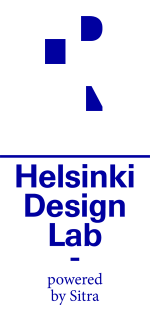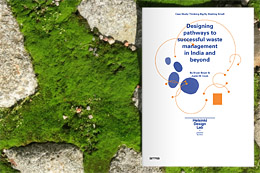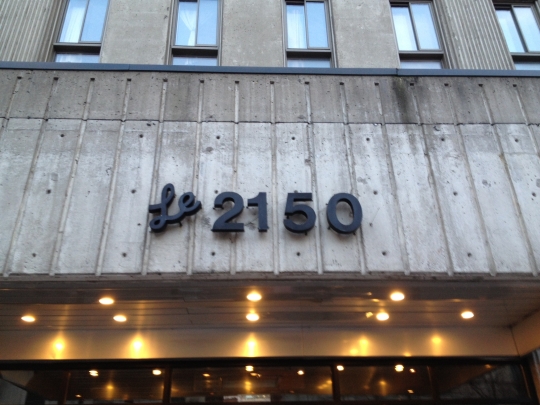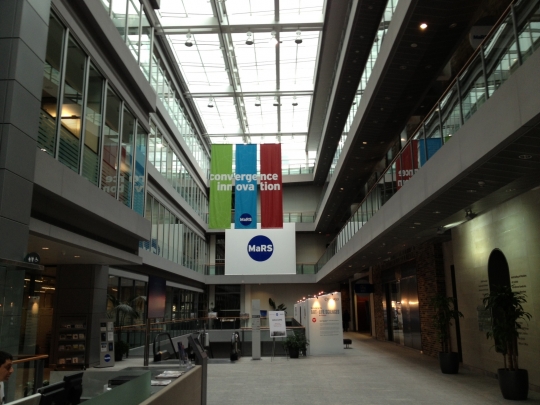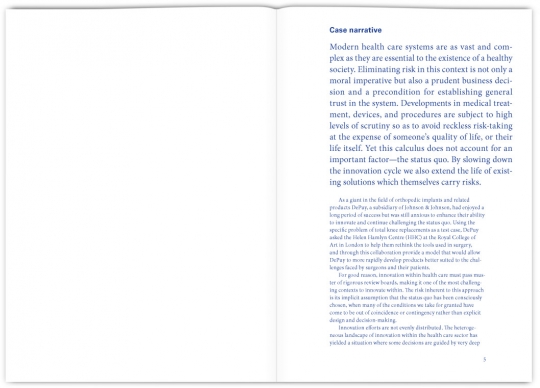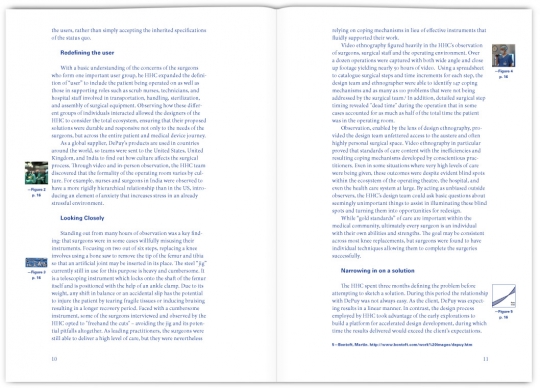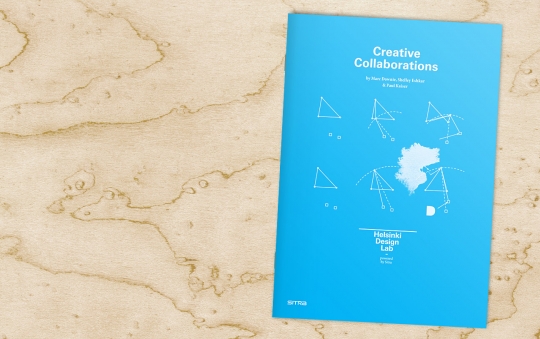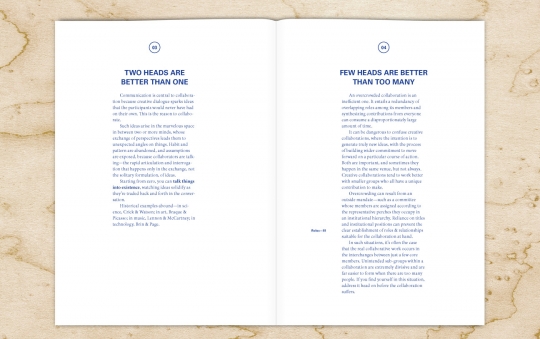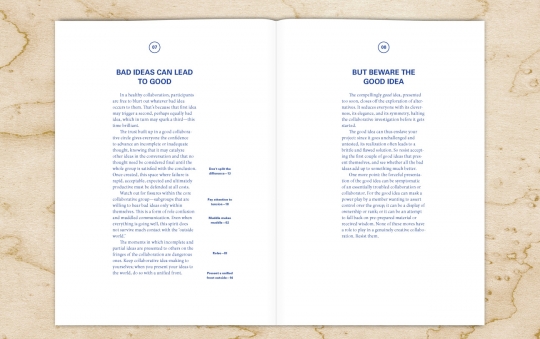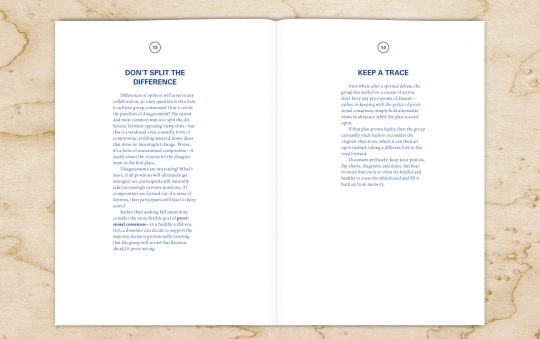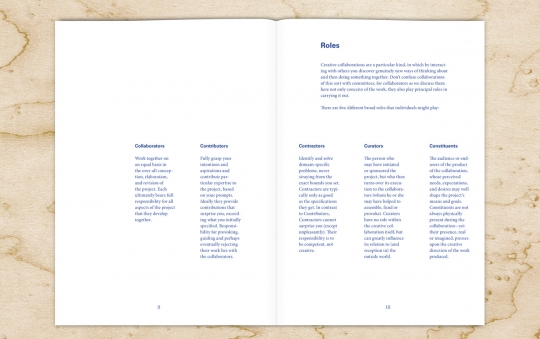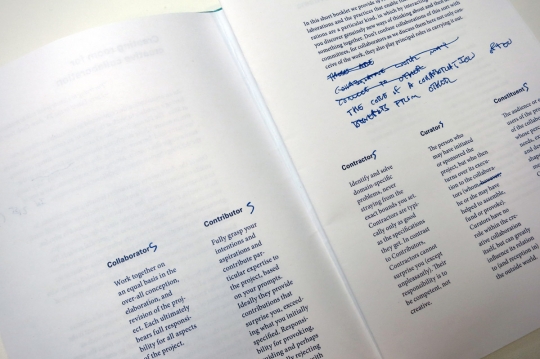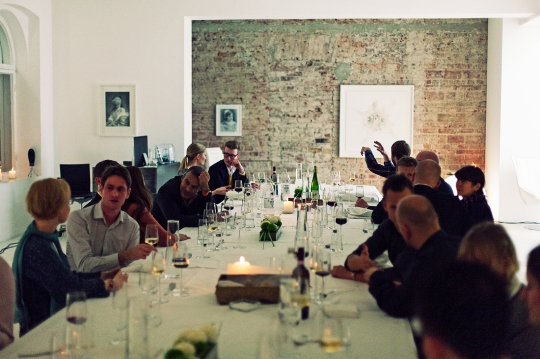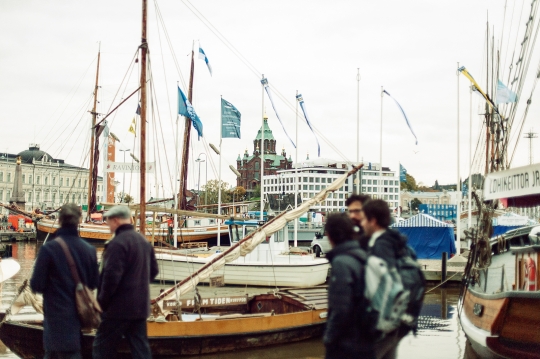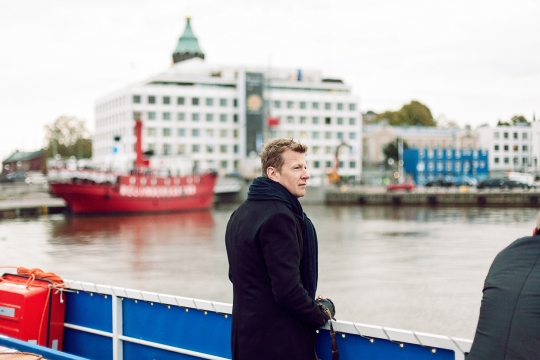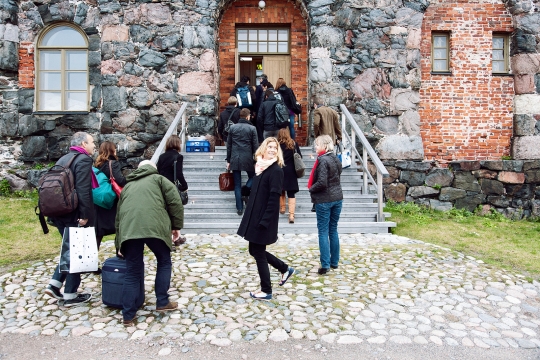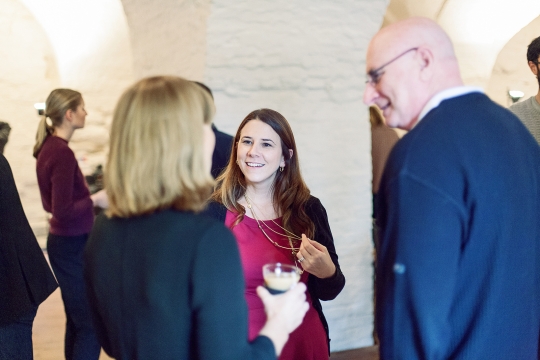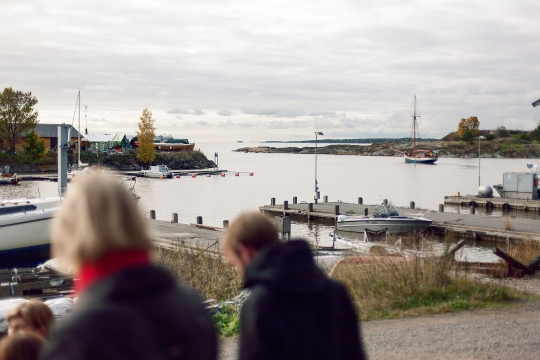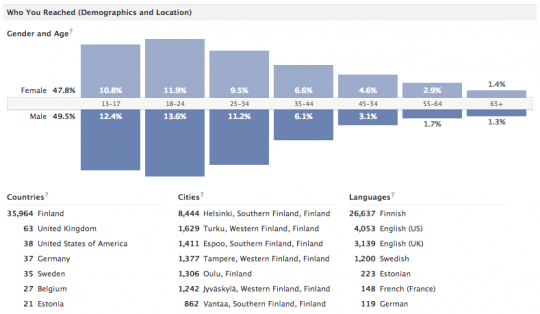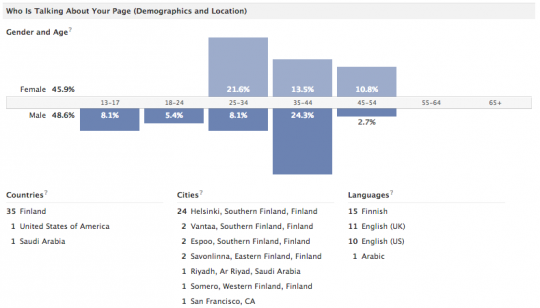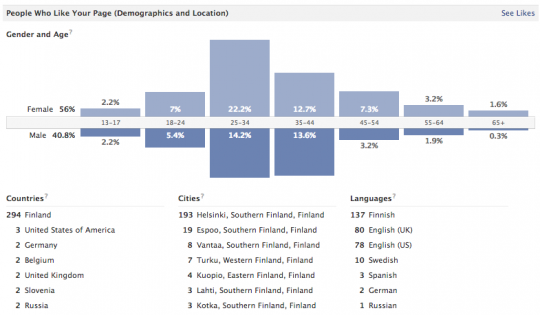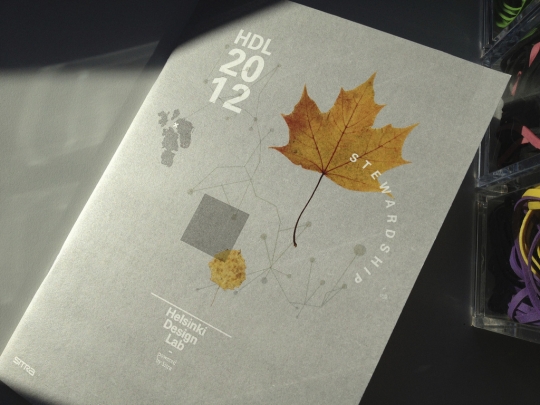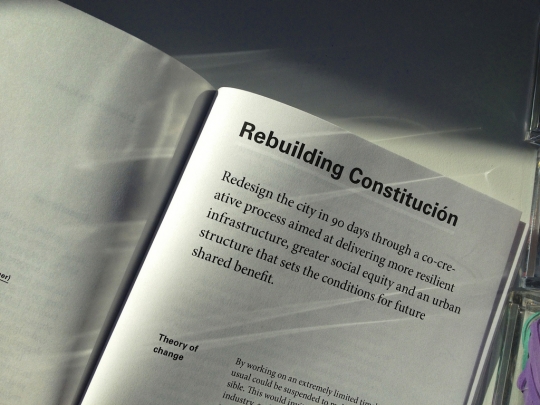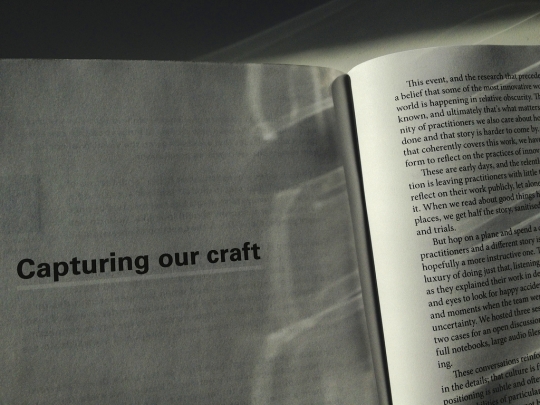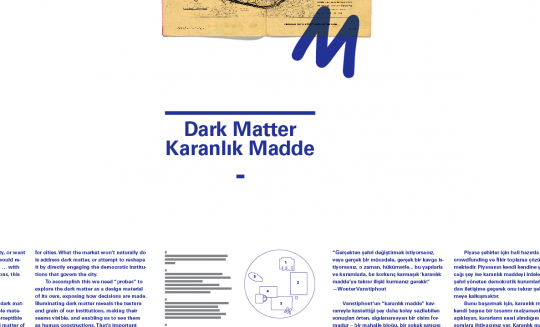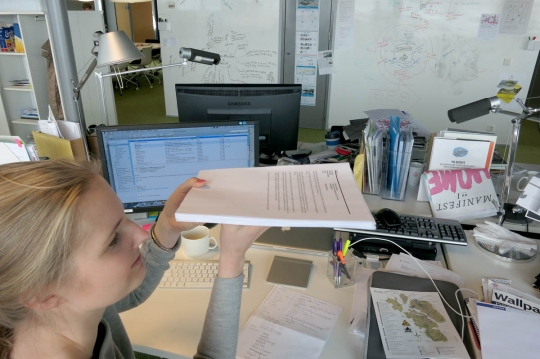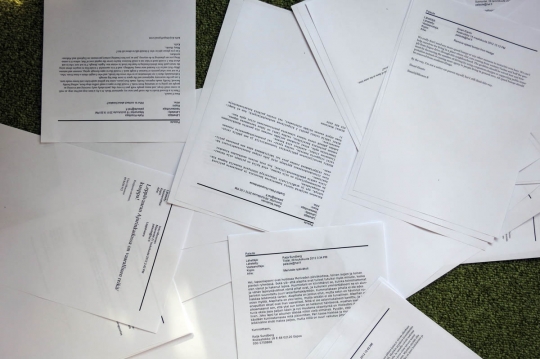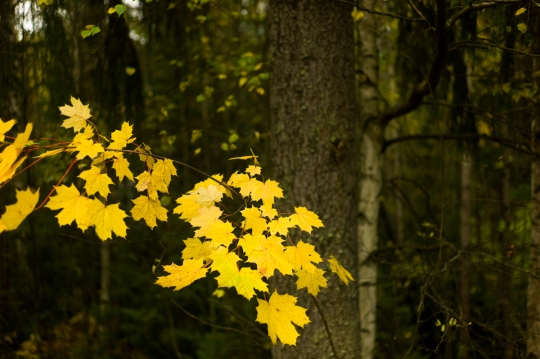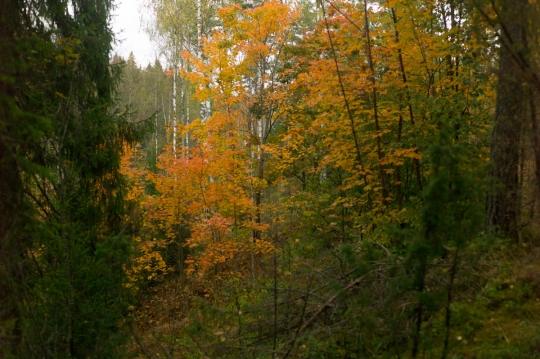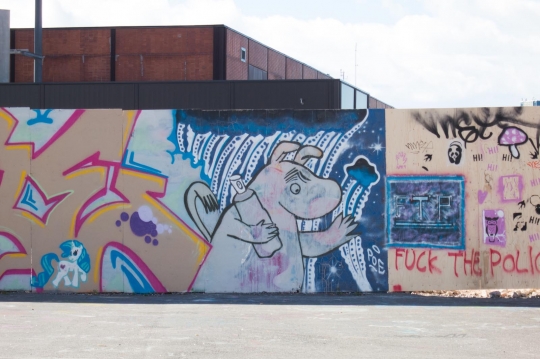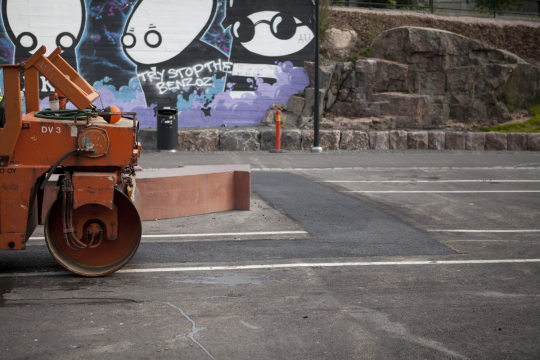Helsinki Design Lab helps government leaders see the "architecture of problems." We assist decision-makers to view challenges from a big-picture perspective, and provide guidance toward more complete solutions that consider all aspects of a problem. Our mission is to advance this way of working—we call it strategic design.
First, some big news. We're sad (but proud and also happy!) to announce that Dan has moved on from Sitra and has taken up a new post as CEO of Fabrica, the communications research center of the Benetton company. He will be back to make a final post on this blog in the nearish future, but currently he's a bit pre-occupied with his new work in Italy. As you might expect!
Second, some less big news. We published four booklets recently. Read more about them here and here.
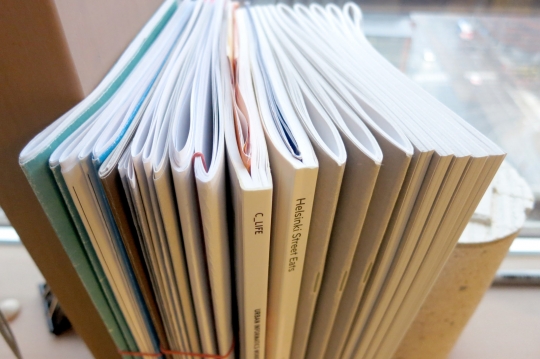
Publication dummies all lined up
It's only Wednesday so this weeknote is coming early. I'm in the air somewhere halfway across Canada. Actually, just south of a town called Outlook, which is an ironic thing to spot when glancing up from my inbox to scan the inflight map.
Tim Dramin and his excellent team at Social Innovation Generation (SIG) have been hosting me for visit to Toronto these past two days. MaRS has been by nexus during these days and it's a bit like hanging around an alternate reality version of Sitra. We're different in important ways (they incubate and we don't, for instance) but there's a familiar buzz in the air. Before that I was in Montreal with the McConnell Family foundation, and currently I'm on my way to Vancouver where I'll be hosted by Al Etmanski of SIG West.
These days have been (and will continue to be) packed. Canada seems to be mobilizing quite an effort around labs of various sorts: design labs, change labs, social innovation labs. There's an investment in codifying the various types and I'm curious to see how this evolves. Lisa Torjman's paper from earlier this year, entitled Labs: Designing The Future, is a good starting point, as is the Policy Horizons Canada document which was recently published. HDL's appearance in both have provided useful opportunities for us to see ourselves anew through someone else's analysis.
We got roped into the lab discussion in Canada and have since been enjoying an ongoing dialogue about what a lab is and what it does well. But here's a secret: we didn't choose the name "lab," we inherited it.
To be honest, all of us here on the HDL team have felt a bit uncomfortable with the term since we started ramping things up in 2009. Our initial skepticism came from a sinking feeling that "lab" was a bit of a trendy term. On the other hand, there was already momentum behind the name, and something of a legacy. So, as hard as we tried to make up a better name, we weren't able to. We accepted it for what it was and is: just a name. Plus, it performs well as a search term, which is not to be underestimated.
If I remember correctly, the top alternative was Strategic Design Lab. The reason we nixed that option is because it's too generic. It's harder to search for. It gives you nothing to grab onto. Our work, even when we have a global perspective, is rooted in Helsinki. It's an ongoing discussion and an evolving practice that draws from the legacy of Sitra and that of design in Finland and the broader Nordic region.
And almost by accident—or was it subconsciously?—we've arrived at a place where many of our projects are situated within the city. Today more than when we began things, our work is starting to look like Helsinki Design Lab. Speculating on and prototyping future Helsinkis. That's a topic for another day.
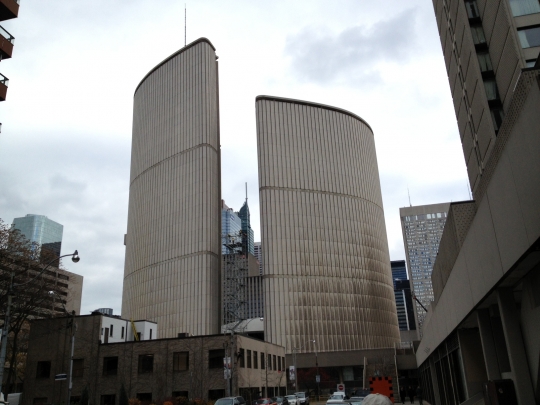
Toronto City hall designed by Finnish architect Viljo Revell
Still, "lab" has been the active word in my trip to Canada and I've been reflecting on how we define ourselves as a lab. If we're to own the fullness of the name Helsinki Design Lab, what does that mean? What is a lab? What is our lab? The notes I wrote on my way to Canada earlier this week:
Lab: platform for coherence and continuity
Lab: conducts experiments to generate evidence that guide further experiments
Lab: should have a portfolio of activity (not just one thing)
Lab: not a process but a practice
Lab: a place (but nothing fancy)
Lab: a core team
Lab: has a set of (consistent) tools
Lab: hosts an evolving conversation
The strength of our lab resides in the fact that we're able to work in an agile or nimble manner. Continuity on a basic level (funding, infrastructure, team, tools) enables us to pursue an evolving portfolio of projects using whatever combination of processes and tools are most appropriate for the specific projects at hand, in the specific moment.
This agnosticism towards tools and processes enables us to be flexible and opportunistic when we need to be—or put another way, when being flexible is the cheaper, faster, or easier pathway to our desired impacts. When we need to pivot, we can pivot. But pivoting is not easy, so the continuity of our shared practice is important. We've literally had to practice this work together to become adept at it. It's a new approach to producing social change, so I think it would be silly to assume that we could get that right without practicing in quite a literal way. One can only read so much music theory before sitting down at the keyboard, as it were.
In practical terms this means that we maintain a basic ability to reallocate our staffing, our budgeting, and our approach to a problem when necessary. This is not easy, but it's critically important. By definition, when doing something truly innovative it's not possible to predict all aspects of the work in advance. With the hindsight of 100 years from now, the belief that such planning and prediction is cheap enough to bake into everything we do will seem like a glitch. Measurement and feedback loops, yes, but we will have to find a way to integrate some degree of fuzziness.
Factories stamp out the same ole widgets, but labs are about developing an understanding for how to do new things. They are places where we expect to see configurations of equipment half deconstructed and reassembled into motley but functional piles. It's not just our desks which are messy at HDL/Sitra Strategic Design Unit, our work is also messy and unpredictable at times. It speeds up and slows down; it goes over budget and sometimes comes in under budget; but every now and then we hit upon something truly effective and that helps us learn about the world.
For a lab, and especially a lab situated within an organization like Sitra that has a financial acumen, the portfolio is the most natural scale of evaluation. Is the sum total of everything the lab is involved in net positive? It's easier for our colleagues in the endowment capital group to check their mixed portfolio of different asset classes and get a sense of whether the numbers are up or down—regardless of asset class, they're all reporting in euros. For our work we're sometimes struggling to make sense of numbers, intuition, and narratives. These make difficult bedfellows as metrics to assess a single portfolio, but it's something that we've developed a skill at through a four year conversation within the team. Good. The next question is how to codify that so that the next group can figure out how to do it in half the time. Eventually we'll all get there.
That's the thing, isn't it? We have 150 years of practice (or more) in predicting and working with financial indicators. It may be extremely important to develop ways to do the same with social indicators, but that doesn't mean we should expect that it will happen faster. We can and should desire that we, as a society, skill up in this area much more rapidly than we did with financial capital, but the likelihood is that we will be struggling with these questions for decades to come.
So I return to the lab as a platform of continuity that hosts an ongoing and evolving discussion around a limited set of issues. One that nurtures knowledge and produces evidence. One that serves the outside world and itself benefits by having feedback loops that enhance the next efforts. The goal of our science labs is not just to produce breakthroughs in their own particular corner of study, but also to become better at science itself.
The practice we're nurturing is strategic design. We're developing a way of designing tangible projects that help us identify and act on systemic change opportunities. We're developing ways to use projects to help us see and then change our cultures of decision-making. We're developing projects that have incremental tangible outcomes so that if they become compromised, canceled, or failed before reaching their final goals that we will still be left with some form of net positive results.
Tomorrow comes to us courtesy of the relentless incrementalism of today, and sometimes (but rarely) we find a beautiful shortcut. If there's one thing a lab does, it's to deliberately search for these shortcuts and then run through them as fast as it can.
The quick update is that the three case studies we've had for a while are now available as print on demand booklets and as revamped PDF downloads. Nestled amongst the flora and minerals of Helsinki, they look like this:
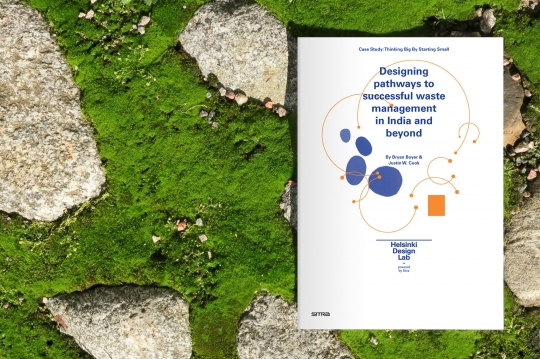
Download Thinking Big by Starting Small as a PDF, order a printed copy, or view online.
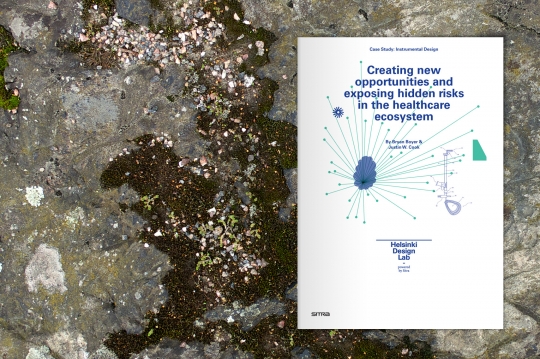
Download Instrumental Design as a PDF, order a printed copy, or view online.
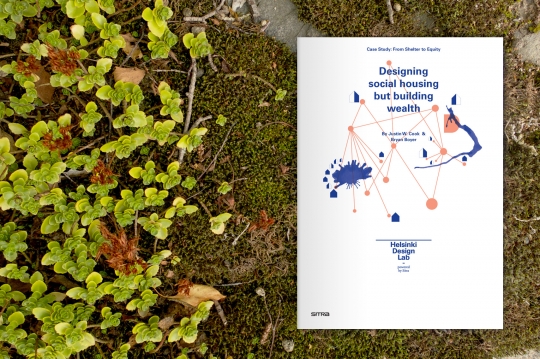
Download From Shelter to Equity as a PDF, order a printed copy, or view online.
The content is 99.8% the same, but we've changed the format. When we started this iteration of HDL we felt the need to create a bit of literature that would describe strategic design as we saw it. At that point, in late 2008 / early 2009 we had not done any Studios, Low2No was not launched yet, and the other projects were not even on the radar. So we needed examples.
The cases became those examples and we felt that it was important for HDL/Sitra to act as an objective voice that could discuss the good, the bad, and the difficult in each of the cases. So we set out to write about design in a somewhat unusual way: the subject was design activity, but we imagined ourselves writing to an audience of policymakers. The task with the cases was to figure out how to demonstrate the value of the strategic design approach. This seems more commonplace now, but there were few people using design and policy in the same sentence in 2008.
An animation depicting the writing process for the first three case studies in early 2009
This led to rather long documents that thoroughly document the work. But at the same time the length of the cases makes them somewhat difficult to approach. They're long, but what if you only have a few minutes to read?
In reformatting them as booklets we've tried to address this in a couple ways. The first of which, and the only new writing in the booklets, is to provide a bullet-point overview right at the beginning. On the left column of the overview you see the story in a few bullets. On the right you see 'points of practice' that are drawn from this.
Borrowing from the design of the case pages on this website, we've started each narrative with a paragraph in large letters. As the table of contents for each one reads, if you're short on time, just read this one page. The first paragraph or two tells the story from end to end. Hopefully if you read this one page you'll be convinced to give the rest of the document a shot.
The body of the text is unchanged. We've adopted a format for these pages that puts the images in the margins as links to a figures section. In all honesty, keeping the full images in a figures section makes the layout work much quicker since we don't have to adjust the flow of the text to the images. With this done in my free time between various other projects, time was an important consideration. If we had more time it would be nice to draft a set of questions that could be used in conjunction with these documents in a teaching environment. Someday.
Redoing these cases was a pretty quick project, but I hope the extra effort was worth it, and that it gives them something of a new life. Or rather, I hope you give them a new life by downloading and reading them.
But now a moment to reflect on one of our miscalculations during the last four years. When we launched this website we thought that there would be plenty of cases out there just waiting to be documented. In early discussions with BERG, who helped us nail down our strategic positioning, we talked (dreamt?) about a regular flow of case studies. At the time we thought there must be tons of people practicing strategic design that we just hadn't met yet. We would take submissions on the site and then publish the best on a yearly basis. Or so we thought.

From an early strategy session. In the top left there you can see the idea of an annual case study book.
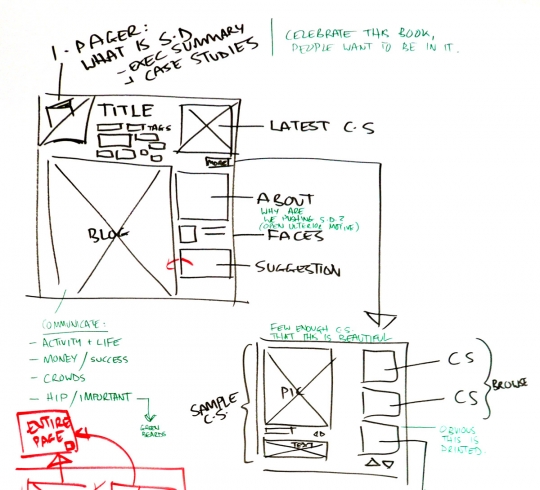
Early website wireframe: "Celebrate this book. People want to be in it."
This was before we set about drafting a long list of cases, querying our network for suggestions, and then doing the research on a short list of possibilities. What we found is that the total number of cases was in the 10s, not the 100s. The pipeline that we imagined was not gushing; it was barely a trickle. This made the cases we did find more precious, but it also meant that some of the assumptions about the total volume of work were incorrect. We were careful to be very specific about what qualified as a strategic design case study, and the result is that very little qualified. I stand by the decisions that we made about narrowing the scope, but it means that we also narrowed the volume.
Unfortunately, we were moving so quickly that this visioning process was going on at the same time as we were building the website and we faced a choice: how to handle case study submissions. On the assumption there would be a steady stream of strategic design cases, we designed an elegant case study submissions process with the help of XOXCO and Rumors Studio, who were the team that built this site.

A screenshot of the submission process (still live) which gets little use.
The case study submission process is a pretty complicated thing to build but the team managed to make it seamless from a user perspective. The work is top notch, but I'm sorry to report that it has been used a total of less than 10 times. 10 times in four years! Admitting this is painful because it means that we spent money and time to automate something that didn't need to be automated because there is not enough volume. Admitting this is painful because it means I made an error of judgement.
It drives home a point made by Joi Ito, one that I refer to regularly these days, so excuse me for being repetitive: it can be more expensive to plan and prepare than it is to develop and test with real users (particularly when considering software). If I had a time machine I would jump back to 2009 and tell younger-me to slap a basic contact form on the submission page and see how it goes. Just deal with the (presumed) onslaught of poorly formatted word documents, mismatched PDFs, and random emails. Putting up with it for just a little bit means that you only invest in building software when you know it's going to return value. If there were avalanches of submissions then it would not only be worth the time and money to make an automated submission process, but we would also have examples of what the submissions look like and so we'd be better informed about how the process should work.
But I don't have a time machine, so instead that leaves us here, with me shamelessly sharing our findings and telling you not to invest money in building a custom process until you've done it manually at least 10-20 times.
I'm not fretting, though. Today we have a better handle on what constitutes a strategic design case study, we have a better network that informs us about projects here and there, and more of this design work is being practiced around the world. That's what matters.
Onwards!
At any given moment we're working on things ranging from helping the city of Helsinki develop new service modalities for child care, to proposing a model for low carbon development, to rethinking the way governments interact with citizens—but one thing that's consistent across every project, regardless of content, is the need to collaborate. Simply put, we do almost nothing alone. Today I'm happy to announce that Sitra has published Creative Collaborations, a practical guide for working together, written by OpenEndedGroup (more on them in a second).
You can download a copy here.
By creative collaborations we mean work that, in the words of the authors:
— Follows no leader: Collaborators interact with each other on an equal basis. They engage in a freewheeling dialogue whose process and outcome remain open-ended until they come to a shared conclusion.
— Aim at invention: Collaborators occupy themselves with exploring diverse, far-flung, and even contradictory ideas, keeping at it for as long as required to alight upon a good and novel solution.
Participating in efforts such as this can be awkward, or even difficult, if one is not used to it. There's a rhythm to working together in this way and it's something that one usually needs to grow into, something that one has to practice.
More often than not we are introducing our collaborators to multidisciplinary work and for that reason we found ourselves wanting to have a guide that we could offer. Something that gives people an idea of what they might expect when being part of a creative collaboration.
To help us with this, we commissioned Marc Downie, Shelley Eshkar, and Paul Kaiser, who together comprise the OpenEndedGroup. They've honed the practice of working with others during decades of multidisciplinary arts projects, collaborating with artists such as Merce Cunningham, Bill T. Jones, and Robert Wilson as well with as with conductors, musicians, lighting designers, architects, scientists, engineers, and scholars.
The OpenEndedGroup drafted a text that proposes five roles (Collaborator, Contributor, Contractor, Curator, Constituents) and then 19 rules of thumb for collaborators. The result is a slim booklet that reads easily and quickly. I would have loved to have had this before the Studios we did in 2010 and 2011, for instance. It will be a valuable resource for future studios and other projects.
Sharing this today is part of our continued effort to maintain a legible practice. That is, to invest part of our time in describing how we do our work—how we practice design—in hopes that it will help us learn from our peers.
And because we believe in making everything we do public, we're offering the booklet for free download under a Creative Commons license. If you're the sort who likes to read on paper, you can also get a copy via print on demand service Lulu.com.
Doing the graphic design for the the booklet was one of my summer projects, and itself a collaboration with lots of back and forth between OpenEndedGroup and us as we collectively tweaked the format and the content.

A pile of layout dummies testing different covers and interiors.
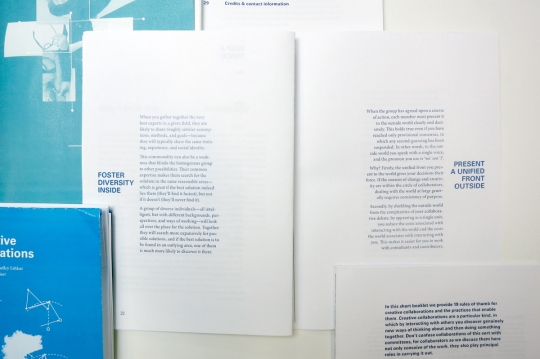
For a brief phase the booklet featured narrative typography, which worked OK on a spread like this, but was difficult to resolve on pages with content that did not lend itself directly to typographic representations.
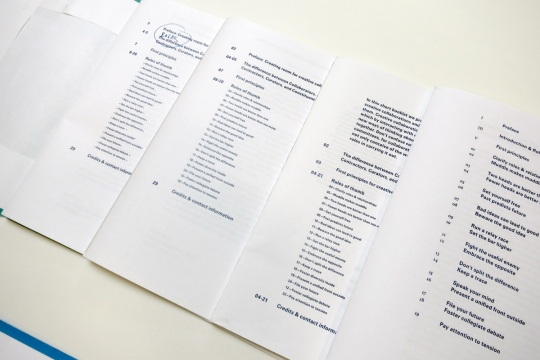
Who knew a table of contents could go through so many revisions?
Many thanks to Marc, Shelley, and Paul for their clear and concise writing. Download a copy and see if you enjoy it as much as we did.
I'll end this post with a request. On our Design Ethnography Field Guide download page we have listed alternative sources in case people want to see similar resources. If you have other resources which are useful guides for collaborative work please leave a message in the comments or let us know via @HDL2010 on Twitter so we can build a pool of resources around this topic as well.
Gray. Dark. From the Sitra tower one sees a vista of offices, homes, and shops glowing warmly beneath a thick cloud cover. The idle booms of a coal ship docked not too far away shine orange under sodium-vapour lights. At ground level metal surfaces reflects the red of brake lights, meaning people are on the way home. Marking the horizon, a strip of faint and fuzzy peach just visible beneath layers of dirty, gauzy, clouds.
More travel these past two weeks (not unlike one year ago). In week 188 Marco was at Dutch Design Week and then at a session at the Danish Parliament (which we all enjoyed hearing about because we are hopeless Borgen fans). He's just back from Moscow, where he was part of a session on the development of Skolkovo. Last week I was in Portugal to give a talk at Cidadania 2.0 (Citizenship 2.0) and then took a day off in Barcelona before coming back north. While there it was nice to catch up with Martin Lorenz and Lupi Asensio of TwoPoints, who did the visual identity for HDL as well as the design of In Studio.
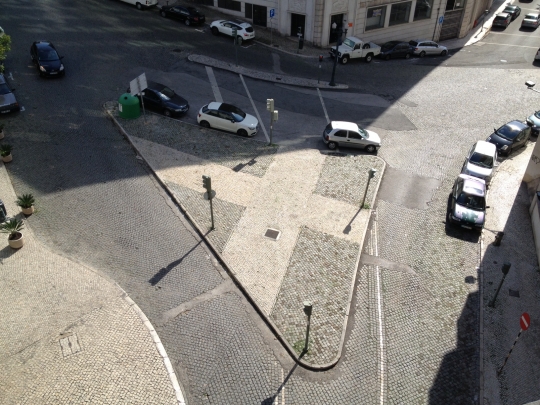
An almost-Finnish-flag literally on the streets of Lisbon
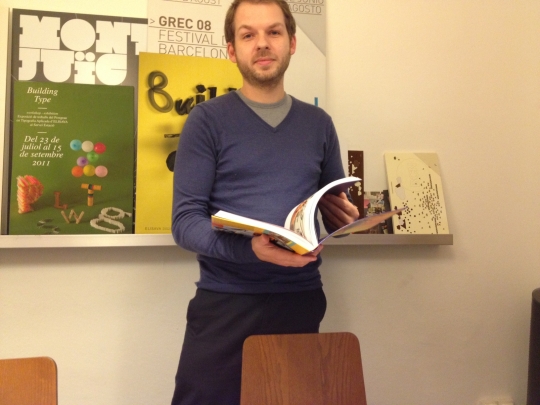
Martin explaining that "there's no ugly anymore, just boring."
In Lisbon Frederico Duarte gave me a tour of the city (and its food). A couple months ago Frederico wrote about Helsinki Street Eats in a profile of the city that he did for Fugas Publico, so it was nice to be able to meet in person. His own recent publication on the cakes of Portugal is an enticing read. I'm quite glad that I got a copy of it at the end of my trip or I might have come back a few kilos heavier.

Lisbon has a nordic nightlife corner with clubs named Oslo, Copenhagen, and Viking. Who's going to start Helsinki?
On Monday we announced the participants for Open Kitchen. Out of 53 applicants we were able to make room for 13. The response was overwhelming and most of the people who applied did so by video (as we requested). The enthusiasm and eloquence in the videos is something that we want to share with you too, so Kalle is hard at work editing them into a single clip. Once we do that and get permission from everyone we'll post it here and on the Open Kitchen Facebook page.
The diversity of the applicants is what excited me most. From 19 to 40+, Finland to Brazil, burgers to ancient preservation techniques, we had a bit of everything it seems. We tried our best to capture that in the final group:
- Archibong wants to fuse African and western food
- Saila wants to give shape to a new kind of ice cream
- Mark dreams of smoked meats (and some bacon sandwiches, we hope)
- Anni believes in stylish an uncomplicated lunches
- Fatim's social kitchen will be an anchor point for newcomers to Finland
- Alba will bring the warmth of Mediterranean dining to Helsinki
- David is investigating ancient preservation techniques
- Elaine is going to show us how Brazilians do effortless nose-to-tail dining
- Jérôme tells us that bread is about friendship
- Jonatan & Nicklas are pure energy and enthusiasm
- Nguyen thinks Vietnamese food in Finland can be better
- Veronica believes in food, flowers, and friendship
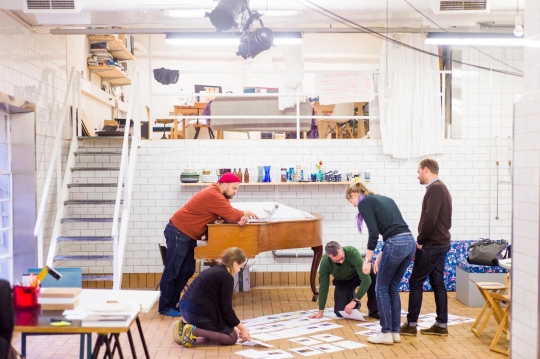
Jurying the Open Kitchen applications was quite a task.
Next steps with Open Kitchen are to launch a similar call for two design students to help the team design and build their prototype restaurant. If this sounds interesting to you (and you're based in Helsinki) please follow the Facebook page for an update next week.
Brickstarter needs more attention than we're giving it at the moment. Maija, Dan, and I have a lot of writing to finish up. We sketched that out on the whiteboard last week, but unfortunately there's is not yet a device to turn marker scribbles into coherent, articulate prose. We are currently exploring the possibility of doing a MVP (minimum viable product) version of Brickstarter with a municipality that's east of Helsinki. More details when they're stable.
A trickle of HDL 2012 feedback has been coming in, including corrections and amendments to the cases we wrote. Next week we will be making some decisions about whether or not we put the cases together into a publication, and if so how. That's part of a larger discussion about what the future holds for HDL.

A wood-fired car visited Sitra. It's gasifies wood chips!
Which leaves us with a long overdue project, a booklet that we comissioned the OpenEndedGroup to write. I spent the week checking all the final boxes so that this can go to press and get pushed live on the website for downloads. That'll happen early next week, so all I can do for now is tease you with these images. It's a plain spoken booklet about how to collaborate on creative projects. It's the kind of thing we might encourage people to read before joining us for a studio, for instance.
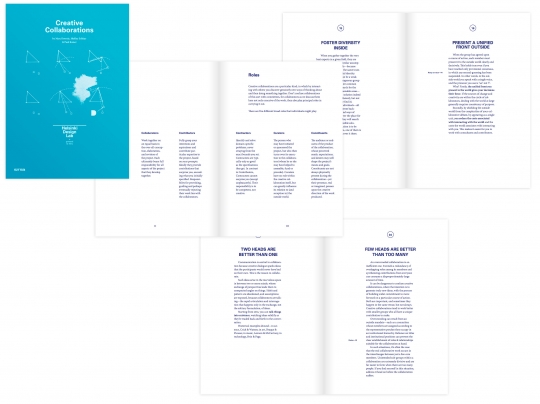
Creative Collaborations by Marc Downie, Shelley Eshkar & Paul Kaiser. Publication forthcoming!
Before I end this weeknote and begin my weekend, two announcements for November. Social Innovation Generation (SIG) is hosting me for a tour of, well, most of Canada. In Toronto I'll be giving a public talk that you can sign up for here at 18:00 on the 12th. We've had an ongoing discussion with SIG and a few other groups in Canada, as well as receiving more than a couple visitors here at HQ, so I'm looking forward to seeing things on the other end of this cross-atlantic friendship.
After Canada I will be heading to Rio de Janeiro to give a talk at the Creativity World Biennale. And then I will sleep for a week straight.
It would be excellent to meet readers of this blog at these events. If you're attending please say hello.
To supplement what Dan wrote about the proceedings of HDL Global 2012, I wanted to share some of the photos from the event as well. Thanks to Johannes Romppanen for all of these!
And more on Flickr.
We're now working on the cases from HDL 2012 to get them into a format that can be shared more widely. No promises on the timeline for that, but perhaps early-mid next year.
It's only tuesday and already the supply of stroopwafels in the office is dangerously low. As is customary on our team, on a trip to the Netherlands one is obligated to return with wafels. I was in Eindhoven at the end of last week and I did my duty, but apparently I miscalculated the quantities. More about the trip in a moment, but first we need to get to something rather incredible.

Open Kitchen also has a new logo courtesy of Sanna Mander!
Applications for Open Kitchen closed last monday and we got roughly 50 applications and the lot of them are impressive! We asked people to make short videos that describe themselves, their experience, and how their food concept will make make Helsinki a better place. The applications included people who excited about cakes, tapas, pho, flat whites & avocado toast, flower ice cream sculptures, traditional food preservation techniques, burgers, sourdough breads, and someone offereing a conceptual menu that begins with a starter of "loneliness" and continues with an entrée of "empathy". So in other words, this is all fantastic.
What we heard from the application videos is that Open Kitchen is exactly the sort of thing people have been waiting for. Now begins the difficult task of winnowing it down to a batch of ~12 people who we have room for in the programme. Tomorrow is the day for that and we'll be balancing multiple criteria:
- Sustainability: is there a concern for local and sustainable aspects of preparation, logistics, consumption, recycling?
- Diversity: is there a new kind of cuisine, a new experience, or a new perspective?
- Everyday: is the applicant interested in basic food experiences (not fine dining) that improve everyday life?
- Social: does the applicant see food as a social object that creates a bridge between diverse publics?
- Drive: does the individual show drive, determination, spark, verve, commitment?
The final selection will be posted next week. We are also hoping to post some examples of the applications, but first we need to get permission from the applicants.
To get the word about Open Kitchen we did an experiment with Facebook ads. We spent a total of €350.62 running two parallel ad campaigns for about 3 weeks. These were targetted to all people living in Finland age 17 or older (about 1,969,280 total Facebook users). To put this into perspective, it would cost €430 to have a banner ad on the popular Nyt.fi website or about €3,000 to have a small ad in the print version.
The response was rather rapid and we saw significant growth of the likes on the Open Kitchen Facebook page, an increased number of questions, and people sharing our posts. What we don't know yet is how many of the applicants found out about OK on Facebook versus other channels. Kalle will be following up with everyone to inquire about that so we have a better picture of how useful this method of advertising was. Here's a view of the stats for the lifetime of the campaign:
Dan had a good meeting with Jaana, who is our Design Exchange person working at the Helsinki Department of Social Services. He, Marco, and myself will swarm with Jaana on a quick project that she's starting now. The gist of it is that there will be an experiment in making preventative help more accessible, ranging from basic parenting advice up to complicated social difficulties. We think this means a combination of new online and offline possibilities to get access to help before there's a problem, but we're not exactly sure yet what shape this will take. It's Jaana's project, but we're here to help.
Down in Istanbul our installation of Brickstarter is now open to the public as part of the Istanbul Design Biennial. If you're not able to see it in the flesh, you can check out the boards we presented here and a bit of backstory here. This opportunity came up at the last minute and it was quite a lift to get the exhibition squared away while also finishing up everything for HDL 2012, but in the end I'm quite happy with how things came out. As an added bonus, the boards for the exhibition are useful as slides to be used in Keynote (thanks to the magical Magic Move transition).
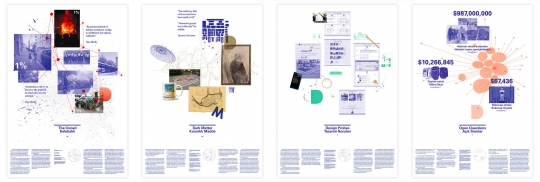
The Crowd, Dark Matter, Design Probes, Open Questions
After HDL Global 2012 concluded Marco and I both got on planes for Italy. He took a well-earned week off with his family. I was headed to European Center Living Technology to share our perspective on strategic design as part of a meeting about Envisioning a Socially Sustainable Future.

While in Venice I had a morning to visit the Architecture Biennale, which was useful to see in comparison to our own work in Istanbul. We've installed a "grumpy printer" and it appears that FAT are of a similar mind with their contribution in the Biennale (one of the highlights).
From there it was on to Ljubljana to be part of their Month of Design with a delegation of other colleagues from Finland.
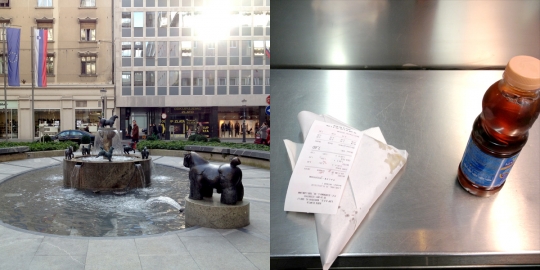
Out and about in Ljubljana. A local friend took me on a street food tour, of which the Burek was the highlight.
And the week ended in Eindhoven where I gave a talk at the World Design Forum and then loaded my suitcase with stroopwafels. Doug Belshaw's thoughts on that event are worth a quick read. Hearing about Doug's work on the Mozilla Open Badges project was one of the highlights for me, as was getting a chance to catch up with John Thackara who moderated the day with aplomb. The organizers have also posted a summary, which is impressively quick considering our HDL 2012 event happened more than a week ago and we're still ruminating.
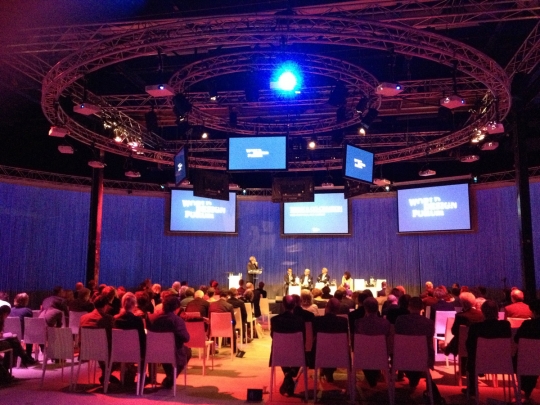
The World Design Forum featured an impressive number of projectors. So many that it kept distracting me from the discussion.
Marco is in Eindhoven now and Copenhagen later this week for Creative Summit (PDF link), Justin's in Boston, Dan's holding down the fort, and I'll be in Portugal for Cidadania 2.0 (Citizenship 2.0). Between travels we're continuing to process HDL 2012 so that we can post more reflections here, picking up where Dan left off last week.
Goodbye, Week 187, you were good to us, but now we must move on.
Last week we hosted Helsinki Design Lab Global 2012. The event was almost a year in the making, and you would've seen it referred to obliquely a couple of times here. We'll post a fuller update shortly, including our ideas about how we will distil and make legible (our favourite word) the conversations and connections.
We use Helsinki Design Lab—this site, social media, publications, events—as our communications platform around strategic design, capturing and conveying the essence of our projects, of other interesting projects out there, or building a network of like-minded folk doing similar work elsewhere, all in an attempt to breathe life into this practice, or culture.
Sometimes this emerges as fully-formed recipe books, sometimes as meetings which are somewhere between therapy and benchmarking. It's our tentative contention that there is a shared culture developing—around getting things done, in a "shared value" public context—and so we work hard to spot useful, transferable examples of such a culture, and bring together the people responsible so they can swap notes and find the time to reflect.
In this mode, our role is hosting, and then we have the privilege of listening, occasionally nudging, before going on to try to distil and document the salient points. More on that later.
But some quick hits for now:
Over the summer, we pulled together representatives of six groups doing interesting work, organised them into three productive pairings in New York, London and Copenhagen. Then we talked, for a day and a bit, about stewardship in and around their projects. It was incredibly interesting, and formed the foundation for last week's conversation.
The six projects were:
- Brownsville Partnership, NYC, by Community Solutions, which we paired with the approach to rebuilding Constitución, Chile, after the 2010 earthquake, by Elemental/Tironi Asociados;
- The Branchekode project by Mindlab within the Danish government was paired with the GOV.UK project by Government Digital Service at the UK government;
- And Nesta's Creative Councils project in the UK was paired with a project by IDEO for the US federal government.
Bryan, Justin, Marco and I then distilled the results of those "mini-summits" into six summary case studies, pulled out some key maneouvres or strategies to form a kind of emerging lexicon (a little like the vocabulary I sketched out a while back) and topped it with a short intro that Bryan and I wrote about this "craft", for want of a better word.
Last week, representatives from those six groups joined us in Helsinki, along with a few other invited guests, to review the cases as we'd described them, and spend a day in shared conversation digging deeper on the topics that emerged.
The wider group included representatives from Bengler (Norway), Cisco/LSE (UK), Community Solutions (USA), Elemental (Chile), Evergreen (Canada), City of Helsinki's social services department, IDEO (USA), Innovation Unit (UK), Mindlab (Denmark), Ministry of Trade and The Economy, Finnish national government, Nesta (UK), Sitra (Finland), Social Science Research Centre Berlin, and Tironi Asociados (Chile). (Government Digital Service couldn't make it as they were launching the gov.uk site, which is fair enough.)
Again, part of this is just bringing a network together. This kind of work is somewhat solitary—there simply aren't that many doing it yet, and although most people who know of it, or hear about it, can quickly see the potential within it, it's still a marginal affair, all told. Important projects; just not enough people doing them. So again with the therapy and empathy-building. But beyond that, we were after what is unique, or just plain useful and productive, about this culture? (And what is not?)
And in terms of that question, HDL Global 2012 had a particular slant. Where HDL Global 2010 had been a larger event, drawing out the network for perhaps the first time, this was a more focused affair. And where 2010 had followed the studios, and focused on the rapid prototyping of vision that was documented in the book "In Studio", HDL Global 2012 focused more on the next step—stewardship. As in, having located a vision, and strategy, just how do you make things happen?
So, this Autumn, an event in Helsinki.
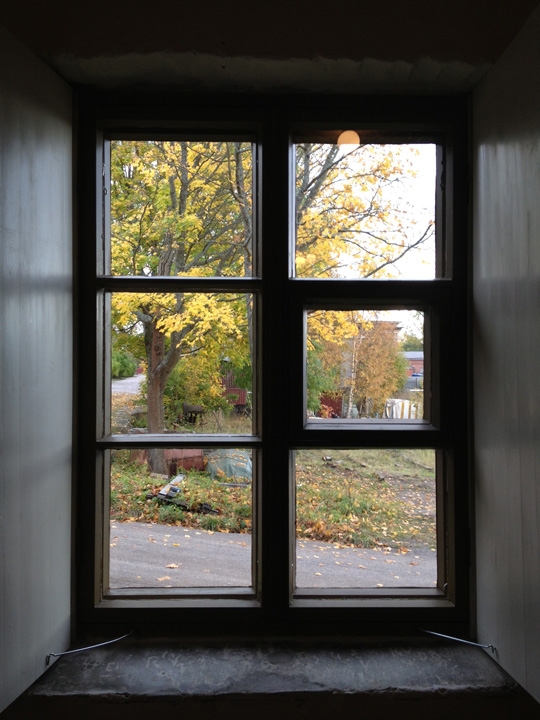
Here is Autumn.
Some details. We sent a small book containing the cases, and background, to the teams as they arrived, the afternoon before the event in most cases. We met for dinner that night. We like to start with a dinner, as it enables people to introduce themselves in a more social setting, and gently begin approaching the subject at-hand at a leisurely pace. You can then hit the ground running the following day. This is partly about getting the messy introductions out of the way, more carefully building relationships without the need for absurd "icebreaker" moments at the start of the event.
And partly because we just like to have dinner.
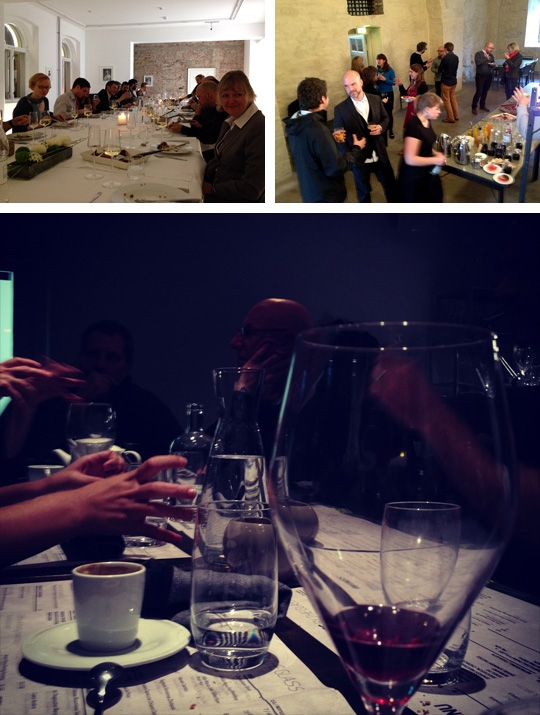
Food as a platform for discussion: before, during and after.
The following morning, we meet at Helsinki's famous Kauppatori (the market square at South Harbour) and take a boat ride to Suomenlinna, the old island sea-fortress that used to guard the city.
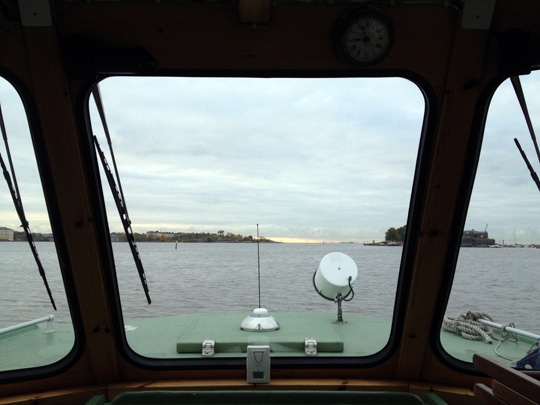
The 20-minute ride to Suomenlinna
Suomenlinna, needless to say, one of Helsinki's great assets and luckily the Autumn weather was just brisk enough to wake everyone up without chilling them to the bone. A delicate balance, round these parts. Our venue was an old warehouse—possibly an ammunition store, looking at how the deep windows were angled—which was an evocative space, and Bryan, Justin, Kalle and Maija did a great job in terms of ensuring the space and the catering were top-notch.

Setting up the venue before the guests arrive.
Our format was simple. Marco started the conversation with a scene-setting talk; Bryan, Justin and I then introduced the cases, and asked for clarifying comments from the participants, as well as reflections on where their projects have gone subsequently.
Then, with breaks, lunch and a walk, we had a group conversation.

Before kick-off.
It occurs to us that we're very comfortable with the open-ended conversation. Those that know us well might say "overly comfortable". That may be the case, but I've had my fill of the alternative: overly-planned, clumsily-facilitated and tricksy workshop formats that leave little room for sudden inspiration or careful reflection, and head inexorably towards whiteboards covered in scribbles captured only in diligently Dropbox-bound photos, or their equivalent, flipchart sheets full of bullet-pointed lists that no-one owns, destined to remain rolled up under the facilitator's desk forever. Whereas the open conversation can be held over the course of a few hours, expanding to a group session in the room or contracting into smaller groups over lunch or coffee, and—given the nascent properties of the subject matter—provide ample room for the genuinely exploratory exchanges required.
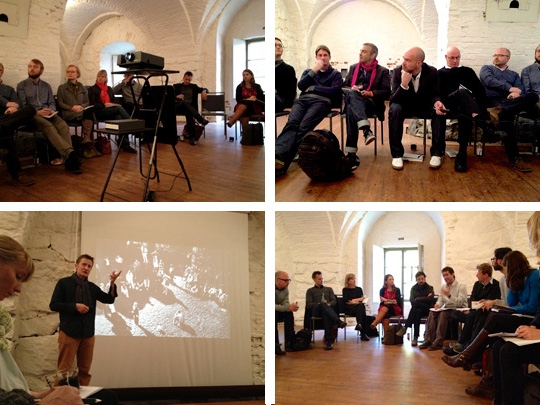
HDL2012, in session.
You might spot Marco operating a slide projector in the photos. This was one of our many subtle (and not so subtle) habit-breaking gestures. It's a basic thought, and perhaps hardly necessary with this particular group, but with the public sector, we often need to derive different outcomes from the same organisations. Given this, one thing we need to do is destabilise the everyday habits of organisational cultures, to shake peoples' defaults, remove the subsconscious inhibitors of change without destroying culture completely. And if a core theme of all of our work is around developing an "institutional sense of empathy", then we need to heighten awareness of the qualities of things, not simply the easily measurable quantitative aspects that bureaucracy all too readily gravitates towards. In practice, this means assessing the symbolic messages contained in active choices about formats, food, location, rhythms, spaces, and so on. It's why we choose a disused warehouse on an island rather than a conference centre or hotel; it's why we had dinner the night before at Helsinki Contemporary Gallery rather than a restaurant; it's why we pay particular attention to our printed matter; and it's why Marco was operating a slide projector.
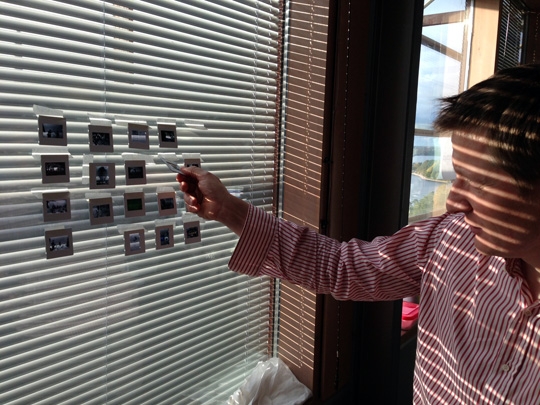
Marco selects his slides before the event.
For most in the HDL2012 group, this was hardly necessary, as they spend most of their days delivering real change in richly messy public contexts, after all. Either way, the conversation flowed readily. Reflecting on it a few days later, it is somewhat extraordinary that we can find very similar approaches to stewardship in projects as diverse as the emergency reconstruction of a Chilean city demolished by earthquake and the redesign of a government web service. But we did, and in the space between all the projects we could see strong connective tissue being constructed across and within the group.
As the light began to draw in, a boat turned up at our dock at Suomenlinna, and it was back to the mainland for dinner, and then flights home.

The last few heading for the boat home.
So that was HDL2012. We have "proper" photos to follow, but more importantly, a sense of where our distillation and documentation might go next. For now, our notebooks, and heads, are full, and while we reflect on the key messages while they're relatively fresh, we would like to extend our immense thanks to all the participants in both the summer sessions and last week's event.
(In other news, applications for our Open Kitchen project closed this week and, having had a quick glance over Kalle's shoulder as they've come in, we're pleased with a good set of diverse applicants. More to follow there too. Ditto Brickstarter and Design Exchange.)
I'm procrastinating. Sitting next to me is a pile of paper covered in red scribbles. Those scribbles need to get into my computer and fight with some pixels. What comes out the other end will be a series of six case studies crunched down into a digestible format. Standing between us and the weekend are 9000 words. It's not clear yet who's going to win this battle.
The team are scattered, off doing various things, and Maija and I are in the HQ tending to the never-ending HDL logistics for next week. Wooden boat? Reserved. Hotels? Confirmed. Having just done a tasting, I can tell you that the reindeer we'll be having for dinner next week is delicious, in case you were wondering.
Marco spent a good chunk of the week interviewing candidates for two more Design Exchange Programme placements. Once they're selected and hired in we'll have a total of four embedded designers.
This is what I keep thinking about:
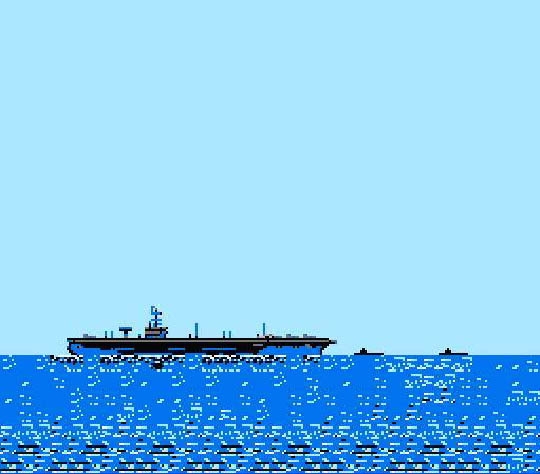
The hardest part of the video game Top Gun was landing your plane on the aircraft carrier. Get the carrier in your sights, modulate the throttle, adjust yaw, avoid roll, and land smoothly on the deck. "Stay on target," as they say.
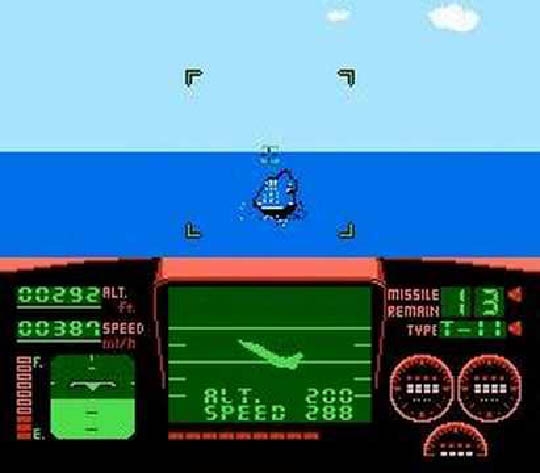
Alongside the preparations for HDL 2012 next week, we've just presentation boards to Istanbul for the Design Biennial there which will feature Brickstarter. Now we know now to say "Dark Matter" in Turkish.
The last piece of that project is an application which will control a laser printer that will be zipping off letters to the 'Public Works Department' on regular intervals. Testing is coming along OK but we still have some bugs to squash.
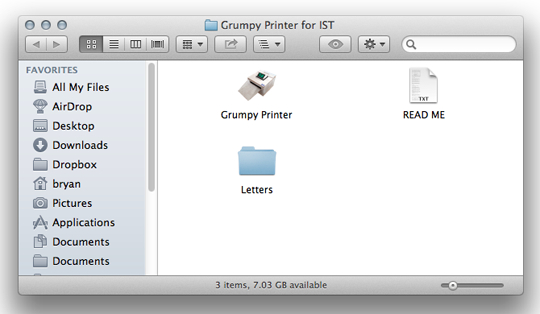
Next week Helsinki will host a gathering of the Délice Network of "good food cities," so we took the opportunity to revamp Helsinki Street Eats to include information about Open Kitchen. We still need to find more time to do a proper update, but for now this is better than nothing. This edition features a new cover as well. Why not. You have 10 more days to apply!
This week was beyond. We're trying to wrap up our Brickstarter installation for the Istanbul Design Biennial, finish case studies of the six projects we learned about this summer, promote Open Kitchen (14 days left to apply!), put together an event with guests from 7 countries on 3 continents, and take care of a few things in between.
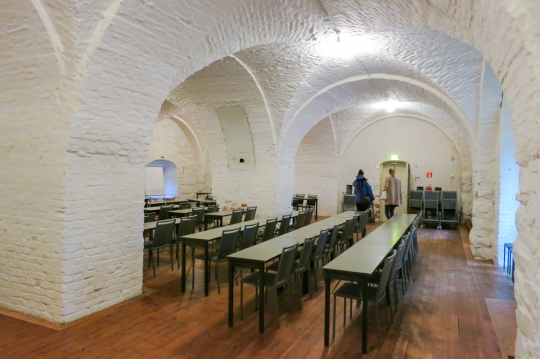
Double checking HDL 2012 logistical details. How's the heat in here? Any extra lighting? Where do coats go? Can we remove these tables?
Marco was at the World Alliance for Low Carbon Cities meeting to give a talk on Tuesday. The same day I was at MindLab in Copenhagen, sitting on a panel organized to respond to and discuss an excellent paper co-authored by Jesper Christiansen and Laura Bunt of Nesta. We'll post a link to the paper once it is published. Later in the week Dan was off to Rotterdam to moderate at panel at the New Towns | New Territories event. Justin held down the fort in the Boston (home) office. Maija and Kalle spent more time than usual at Sitra HQ on the phones, evidence of the fact that these days we're putting things into place.

Hurried writing at one of Copenhagen's nicer cafes the morning of the Mindlab session

A quick panorama from the session at MindLab
And since I'm writing this weeknote, I get to abuse my power and show you what I did this weekend. Although I spent a good bit of it working on the case studies, I couldn't pass up the opportunity to go mushroom hunting (!) with some friends. Glad that I did, too, because the forest is in a beautiful way at the moment.
Oh, a first for us! A two-and-a-half-weeknote.
The most recent round of recruiting for our Design Exchange Programme has closed. We had 46 applications for the Environment Ministry post and 47 for the Ministry of Employment and the Economy. Excellent! Marco and the rest of the hiring comittee are hard at work sorting through those now.
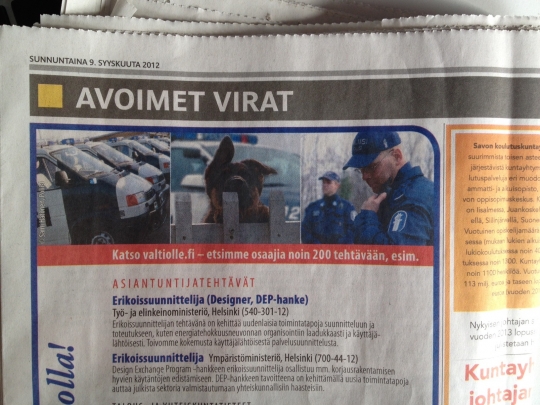
Our DEP positioned advertised in the Helsingin Sanomat... next to the police!
Rory Hyde came to town for a book launch of Future Practice, which includes a forward by Dan and an interview with me.
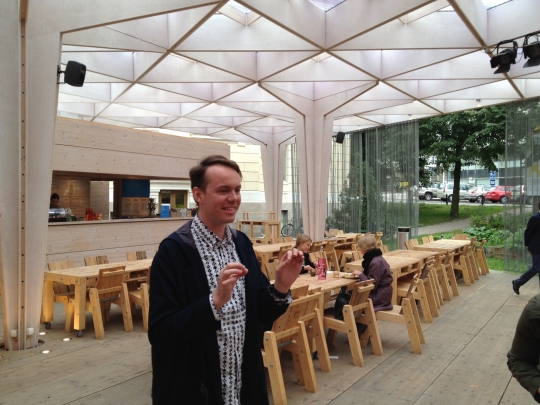
I think he's measuring the gap between today's practice and Future Practice.
We're working on an exhibition of the Brickstarter research project for the Istanbul Design Biennial. It involves things like creating a coffe-stained municipal mug, doing drawings, and writing some simple software.
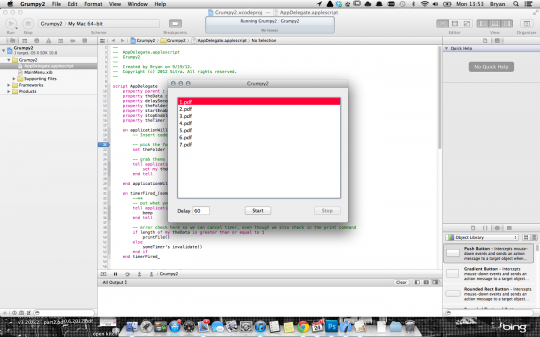
For a fun evening, teach yourself Applescript Objective-C. This will power our "Grumpy Printer".

"What font does a municipality use," Maija asks? "Impact!!!" we reply.
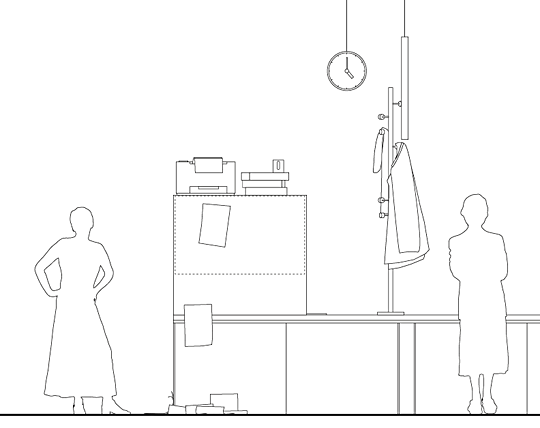
Friend-of-HDL Tuomas Toivonen's song U=Utopia (which was inspired by and namechecks Low2no) was recently covered on episode 16 of Euro crime drama The Spiral.
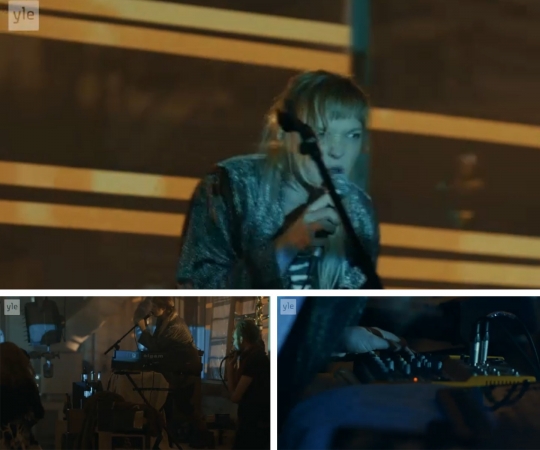
"I know you're angry, I'm angry too" she sings after Tuomas' lyrics
This is funny:
And this is sad:
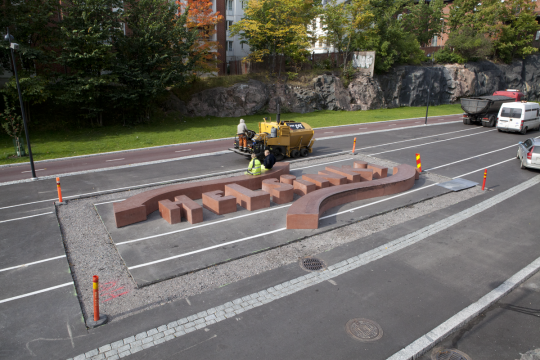
Baana skate sculpture surrounded by a moat that the city dug in response to citizen complaints about noises
Remember the Baana project, mentioned here previously? At one end of this sunken recreational pathway there's a sculpture in the shape of the word "Helsinki" extruded up out of concrete.
Last week a visitor would have found it in the state of the image above, featuring a 'moat' cut through the asphalt all around it. Why? To prevent skating. Originally it looked more like this. It was designed for skating, by the way.
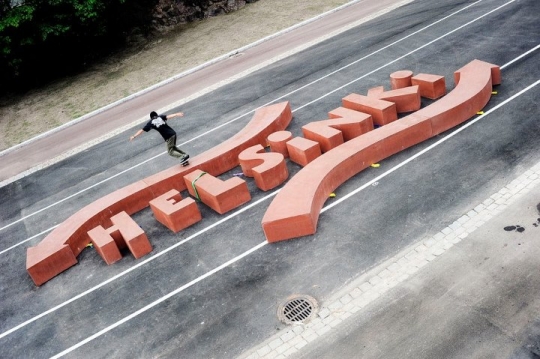
Baana skate sculpture as it originally appeared (image borrowed from Yksivaihde
After an unspecified number of complaints from nearby residents, the skating was deemed inappropriate and the city, as Dan puts rather eloquently, "vandalised their own project" to prevent people from skating. The part that pushes it into full absurdity is when the city's own safety regulations then force it to put orange cones up to mark the moat as a potentially dangerous change of ground surface.
Seemingly before the buzz of the planned 'moat' had even made it around town, the trench was already dug. A high point of city efficiency, to be sure, but not everyone was happy. The entire Baana project had gone through years of development with ample opportunity to comment or complain, as per standard procedures. So why were a few voices able to determine the fate of this city ammenity and have their voices translated into action so quickly, so unilaterally?
Then something doubly surprising happened: the city reacted quickly again, changing tack a second time and announcing that they would re-pave the moat. This restored Baana to its original, skateable condition, but leaves a visible and material scar of the non-debate.
On one hand this is a positive story about an agile city who was able to respond quickly, but on the other hand it's an allegory for the problems to come if we do not have more considered tools to help us negotiate these kinds of questions in the shared spaces of our cities.
Is this much agility always a good thing?

We were lucky to be walking by just as the Baana skate sculpture's moat was being filled in
